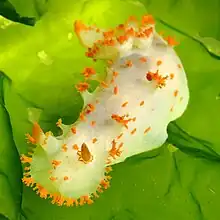Triopha catalinae
Triopha catalinae, commonly known as the sea clown triopha or sea clown, is a species of colorful sea slug called a nudibranch. Sea clowns are a shell-less marine, gastronomic mollusk in the taxonomic family Polyceridae.
| Sea clown triopha | |
|---|---|
 | |
| Scientific classification | |
| Kingdom: | |
| Phylum: | |
| Class: | |
| (unranked): | clade Heterobranchia clade Euthyneura |
| Superfamily: | |
| Family: | |
| Subfamily: | |
| Genus: | |
| Species: | T. catalinae |
| Binomial name | |
| Triopha catalinae (Cooper, 1863) | |
The species' Latin name is named after Santa Catalina Island, California.
Distribution
This species lives in the Western Pacific from Alaska to Mexico, and has also been found in Japan and South Korea.[1][2]
References
- Berhrens, D. W., 1980, Pacific Coast Nudibranchs: A guide to the opisthobranchs of the northeastern Pacific, Sea Challenger Books, Washington.
- Triopha catalinae (Cooper, 1863) Archived 16 October 2007 at the Wayback Machine Sea Slug Forum, accessed 17 July 2009.
External links
Wikimedia Commons has media related to Triopha catalinae.
- SEM images of the radula can be found at Thompson, T.E.; Bebbington, A. (1973). "Scanning electron microscope studies of gastropod radulae". Malacologia. 14: 147–165.
This article is issued from Wikipedia. The text is licensed under Creative Commons - Attribution - Sharealike. Additional terms may apply for the media files.

